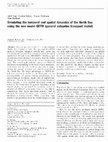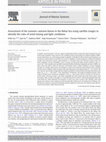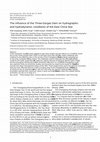Papers by Thomas Pohlmann

A fine resolution model has been applied to get more insight into the effects of a modified runof... more A fine resolution model has been applied to get more insight into the effects of a modified runoff due to the Three-Gorges-Dam (TGD) on the East China Sea (ECS). The region of interest was confined to the offshore area in the vicinity of the Changjiang River. To the east, it extended up to the area southwest of Cheju Island. The model was used to evaluate the effect of a modified runoff on the water properties of the adjacent regions like the Changjiang diluted water (CDW) and the Zhoushan Fishing Ground. The sensitivity of the ECS to a modified Changjiang runoff was explored firstly by sensitivity studies and secondly by experiments based on historical runoff records and water management plans of the TGD. These experiments led to the general conclusion that the most affected area by runoff is located close to the Changjiang River mouth. The area of influence has an extension of about 150 km×150 km. In the realistic experiment, the related anomalies reached their maximum value in early summer (May). In normal years the related salinity anomalies can get to as large as 2.

Journal of Marine Systems - J MARINE SYST, 2004
The suspended particulate matter (SPM) concentration in the Bohai Sea, China, is measured during ... more The suspended particulate matter (SPM) concentration in the Bohai Sea, China, is measured during two cruises carried out from September to October 1998 and April to May 1999. The analysis of the in-situ data reveals two zones of high SPM concentration that can be attributed to Yellow River water as well as to resuspension. The exchange with water masses of the Yellow Sea leads to a reduction of the SPM concentration in the eastern and central part of the Bohai Sea. The field data also show that in the Bohai Sea the wind waves strongly influence the SPM concentrations. This explains the major part of the seasonal variation: the SPM concentration is higher in spring than in summer, which results from the seasonal variation of the wind. A 3D numerical SPM transport model is used in this study to simulate the conditions during two cruises that have been conducted in the frame of the project. The results show that the model can well reproduce the observed SPM concentrations in the Bohai ...

Ocean Dynamics, 2004
Here we present results of a I-year realistic North Sea simulation from the new model GETM (gener... more Here we present results of a I-year realistic North Sea simulation from the new model GETM (general estuarine transport model) and assess the capabilities of this model by comparing them to model results from the well-known HAMSOM (Hamburg shelf sea and ocean model) model, in situ data from the North Sea project and satellite-derived sea-surface temperature data. The annual cycle and the spatial variability of stratification and mixing in the North Sea is simulated. It is shown that the new model is successful in reproducing the general temporal and spatial dynamics of the North Sea. The major advantages of GETM for achieving improved results in this simulation are the implementation of general vertical coordinates, of a state-of-the-art turbulence model and of higher-order advection schemes. By exploiting the full capabilities of these features a more realistic simulation could be achieved. We found that the greatest differences in the model results are produced by applying advection schemes of different complexity. Here we are able to demonstrate that better advection schemes lead to stronger horizontal gradients and stronger vertical stratification during summer. When comparing these results to measurements from the North Sea project and to satellite data, we find that these stronger gradients are more realistic. Therefore, we consider it as essential to use such high-order advection schemes if the spatial variability of estuarine or shelf seas like the North Sea is to be resolved adequately. The advanced turbulence closure scheme also contributed to more realistic simulation of the vertical stratification. Finally, general vertical coordinates better resolve the shallow regions, but are also useful for the deeper regions, as they allow a better estimation of sea-surface temperature compared to traditional (Jcoordinates.

Journal of Marine Systems, 2014
In shallow coastal ecosystems, summer-autumn phytoplankton blooms require thorough investigation ... more In shallow coastal ecosystems, summer-autumn phytoplankton blooms require thorough investigation because of their large variability in space and time. This variability results primarily from the complex interplay of different governing factors, e.g., wind mixing and light availability. To identify the effects of these governing factors on the summer-autumn blooms in the Bohai Sea, we first established a statistical approach to define the biological variables that characterize summer-autumn blooms, i.e., the bloom onset time (denoted as bloom onset), the bloom magnitude, and the chlorophyll-a (Chl-a) increase rate during the bloom period (denoted as Chl-a increase rate). These variables were quantified using daily Medium Resolution Imaging Spectrometer (MERIS) satellite scenes from 2003 to 2009. We observed a remarkable onshore-offshore gradient in all three biological variables. For example, bloom onsets were delayed in coastal areas compared to deep offshore waters. Spatially, the bloom onset exhibited a high correlation with wind mixing prior to the bloom period (R N 0.6), whereas the Chl-a increase rate and bloom magnitude were highly correlated to the distribution of the light attenuation coefficient (K d(min) , R = −0.65 and R = 0.69, respectively). Furthermore, the empirical orthogonal function (EOF) analysis revealed similar interannual variability in the K d(min) , bloom onset and Chl-a increase rate. We also observed similar interannual trends in the bloom magnitude and wind mixing during the bloom period. From the analysis above, we believe that light is a crucial limiting factor for summer-autumn phytoplankton dynamics in the Bohai Sea. Wind influenced Chl-a dynamics in many ways and at various scales. Spatially, weak wind speeds prior to bloom events tended to provide favorable light conditions for the development of blooms. Over the long-term, however, enhanced wind mixing tended to supply the surface layer with nutrients more effectively and thus promoted a higher bloom intensity.

Journal of Marine Systems, 2004
Long-term transport processes in coastal seas with time scales from weeks to seasons time scale a... more Long-term transport processes in coastal seas with time scales from weeks to seasons time scale are controlled by residual circulation. In the Bohai Sea, an ultrashallow shelf sea of China, tidal residual is almost the dominant factor to the circulation due to slight stratification and weak wind in summer. In order to establish an adequate hydrodynamic base to the ecosystem dynamics of the Bohai Sea, the differences of tide-induced Lagrangian and Eulerian mean circulation are discussed and calculated in this contribution. The Stokes drift is analyzed theoretically. According to Longuet-Higgins [Deep-Sea Res. 16 (1969) 431], the Lagrangian flow is the sum of the Eulerian flow and the Stokes drift that is induced by the mean kinetic energy and coastal nonlinear interaction. Stokes drift is large in the coastal sea and in areas where the vorticity and/or divergence are large. Vertical mass transports by Stokes drift are also the result of nonlinear interaction of current, water level and topography. Hamburg Shelf Ocean Model (HAMSOM) is applied in the Bohai Sea to simulate the tides and tidal currents. The tide-induced Lagrangian mean circulation and the Eulerian one are calculated at the same time. In the area where the Stokes drift is in the same direction as the Eulerian residual, the Lagrangian one is stronger than the Eulerian one. Where they are pointing in opposite directions, the Lagrangian one is small, like in the southwest of the Bohai Bay, Liaodong Bay and Bohai Strait. The Lagrangian residual current flows into the Bohai Bay along its southern bank causing deposition of Huanghe River sediments. This is in agreement with observations. D

Journal of Marine Systems, 2008
We employed a coupled biological-physical, individual-based model (IBM) to estimate spatial and t... more We employed a coupled biological-physical, individual-based model (IBM) to estimate spatial and temporal changes in larval fish habitat suitability (the potential for areas to support survival and high rates of growth) of the German Bight, southern North Sea. In this Lagrangian approach, larvae were released into a size-structured prey field that was constructed from in situ measurements of the abundance and prosome lengths of stages of three copepods (Acartia spp., Temora longicornis, Pseudocalanus elongatus) collected on a station grid repeatedly sampled from February to October 2004. The choice of prey species and the model parameterisations for larval fish foraging and growth were based on field data collected for sprat (Sprattus sprattus) and other clupeid larvae. A series of 10-day simulations were conducted using 20 release locations to quantify spatial-temporal differences in projected larval sprat growth rates (mm d − 1 ) for mid-April, mid-May and mid-June 2004. Based upon an optimal foraging approach, modeled sprat growth rates agreed well with those measured in situ using larval fish ototliths. On the German GLOBEC station grid, our model predicted areas that were mostly unsuitable habitats (areas of low growth potential), e.g. north of the Frisian Islands, and others that were consistently suitable habitats (areas that had high growth potential), e.g. in the inner German Bight. In some instances, modelled larvae responded rapidly (~5 days) to changing environmental characteristics experienced along their drift trajectory, a result that appears reasonable given the dynamic nature of frontal regions such as our study area in the southern North Sea.
Dynamics of Atmospheres and Oceans, 2010
A nested numerical model system has been set up to realistically simulate more than 30 years of t... more A nested numerical model system has been set up to realistically simulate more than 30 years of the Indonesian throughflow (ITF). A global circulation model delivered the boundary values for sea level, temperature and salinity distributions to a local model covering the ...
Continental Shelf Research, 1987
A simple Lagrangian transport model was applied to obtain estimates of transport routes of conser... more A simple Lagrangian transport model was applied to obtain estimates of transport routes of conservative passive tracers in the North Sea. A vertically integrated time-dependent flow field derived from the daily output of a three-dimensional baroclinic circulation model was used in the transport model. The simulation period covers the years from 1969 to 1982. The calculations were carried out in
… 2010, held 2-7 May, 2010 …, 2010
The Indonesian throughflow (ITF) as a part of the global conveyor belt plays an impor-tant role w... more The Indonesian throughflow (ITF) as a part of the global conveyor belt plays an impor-tant role within the worldwide water exchange. It is the only low-latitude connection between oceans on the world with a varying transport of water mass and heat from the ...

Acta Oceanologica Sinica, 2011
A fine resolution model has been applied to get more insight into the effects of a modified runof... more A fine resolution model has been applied to get more insight into the effects of a modified runoff due to the Three-Gorges-Dam (TGD) on the East China Sea (ECS). The region of interest was confined to the offshore area in the vicinity of the Changjiang River. To the east, it extended up to the area southwest of Cheju Island. The model was used to evaluate the effect of a modified runoff on the water properties of the adjacent regions like the Changjiang diluted water (CDW) and the Zhoushan Fishing Ground. The sensitivity of the ECS to a modified Changjiang runoff was explored firstly by sensitivity studies and secondly by experiments based on historical runoff records and water management plans of the TGD. These experiments led to the general conclusion that the most affected area by runoff is located close to the Changjiang River mouth. The area of influence has an extension of about 150 km×150 km. In the realistic experiment, the related anomalies reached their maximum value in early summer (May). In normal years the related salinity anomalies can get to as large as 2.

Deutsche Hydrographische Zeitschrift, 1999
ABSTRACT In this article, the hydrographic conditions are described which prevailed in the German... more ABSTRACT In this article, the hydrographic conditions are described which prevailed in the German Bight during the three KUSTOS experiments carried out in summer 1994, spring 1995, and winter 1996. It presents the physical background for the companion articles of this volume and provides insight into the complicated and highly variable hydrodynamics of the German Bight. Typically for the German Bight, the distribution of temperature and salinity in the near-bottom layer was found to relate strongly to the topography in all experiments, and variability in the vertical structure showed the expected seasonal pattern. The thermal and haline stratification were found to coincide in most cases, indicating a clear marking of surface and bottom water masses. Between the three KUSTOS experiments, the intensity of salinity fronts varied strongly, with stronger fronts in spring and weaker gradients in summer and winter, but from the limited number of observations this pattern cannot be generalised. The observed temperature and/or salinity patterns differ strongly from the average long-term situation, as expected in a highly variable area. To a large degree, this variability is caused by mesoscale features which - owing to their transient nature - are not well resolved by in-situ observations during the experiments and, therefore, numerical models are used to complement the observations. Finally, the overall mass transport through the German Bight during the KUSTOS experiments, estimated from a North Sea circulation model and a salt water budget and freshwater balance, ranges between 34 (strong cyclonic circulation) and -3 km3/d (weak anticyclonic circulation). North Sea water advection into the German Bight dominates river runoff by a factor of ∼15 (spring 1995) to ∼49 (winter 1996). However, in situations with a low through-flow in combination with a high ratio of freshwater inflow, residence times of river water can be high, thereby aggravating any harmful effects of riverine contaminants. In diesem Artikel werden die vorherrschenden hydrographischen Bedingungen wÄhrend der drei KUSTOS-Experimente beschrieben, die im Sommer 1994, Frühling 1995 und Winter 1996 in der Deutschen Bucht durchgeführt wurden. Er stellt den physikalischen Hintergrund für die anderen Artikel dieses Bandes dar und bietet einen Einblick in die komplizierte und überaus variable Hydrodynamik der Deutschen Bucht. In allen Experimenten ergab sich ein direkter Zusammenhang zwischen den bodennahen Verteilungen von Temperatur und Salzgehalt mit der Topographie. Die in den Experimenten beobachtete VariabilitÄt in den vertikalen Strukturen zeigte die zu erwartenden saisonalen Muster. Es wurde festgestellt, da\ sich die vertikalen Gradienten der Temperatur und des Salzgehaltes in den meisten FÄllen deckten, wodurch die Unterschiede der Wassermassen am Boden und an der OberflÄche deutlich werden. Die KUSTOS Experimente zeigen eine saisonal verÄnderliche IntensitÄt der Salzgehaltsfronten, mit im Frühjahr stÄrkeren und im Sommer und Winter schwÄcheren Gradienten. Allerdings lassen die verfügbaren Ergebnisse keine Verallgemeinerung dieses Ergebnisses zu. Keine der beobachteten Temperaturoder Salzgehaltsmuster zeigen einen engen Bezug zu der mittleren Lage über lange ZeitrÄume hinweg, wodurch sich die gro\e Bandbreite der VariabilitÄt zeigt. Da mesoskalige Merkmale, entsprechend ihrer kurzlebigen Natur, von den in-situ Beobachtungen wÄhrend der Experimente nicht gut aufgelöst wurden, wurden numerische Modelle benutzt, um die VariabilitÄt teilweise erklÄren zu können. Mit einem Zirkulationsmodell wird der Brutto-Massentransport durch die Deutsche Bucht der Nordsee berechnet; die Ergebnisse zeigen eine hohe VariabilitÄt des Massentransportes. Transporte in die Deutsche Bucht wÄhrend der KUSTOS Experimente reichen von 34 bis-3 km3/Tag, von starker zyklonaler zu schwacher anti-zyklonaler Zirkulation. Eine für die KUSTOS Experimente aufgestellte Salz-und Frischwasserbilanz bestÄtigt die Modellergebnisse und offenbart die Dominanz des in die Deutsche Bucht einströmenden Nordseewassers über die FlusswassereintrÄge. Vor allem im Fall geringen Massentransportes in Verbindung mit einem hohen Anteil an Frischwasserzuflu\ bedingt die entsprechend höhere Verweildauer eine VerstÄrkung der negativen Effekte der vom Flusswasser mitgeführten Schadstoffe.

Uploads
Papers by Thomas Pohlmann